Physical Address
304 North Cardinal St.
Dorchester Center, MA 02124
Percutaneous pulmonary valvuloplasty is the first-line treatment for all patients with more than moderate isolated pulmonary stenosis.
Even in critical neonatal pulmonary stenosis, simple efficacious balloon dilatation can provide a definitive solution and avoid the need for future medical intervention.
Percutaneous pulmonary valve implantation (PPVI) is suitable for patients with dysfunctional right ventricle–to–pulmonary artery conduits and for dysfunctional patch reconstructed outflow tracts in selected cases.
Two stent-mounted valves, the Melody for right ventricular outflow tracts of less than 22 mm and the Sapien for those less than 29 mm, are approved for use within and outside the United States.
PPVI is performed with the patient under general anesthesia, and a femoral approach is typically used. The procedure results in early symptomatic improvement and reduction of right ventricular volumes.
PPVI can be complicated by device displacement, homograft rupture, or coronary artery compression at the time of implantation; these should be avoidable by careful assessment of anatomy and correct prestenting procedures.
PPVI has become part of routine clinical practice, with more than 8000 procedures performed worldwide in the past decade. It prolongs conduit life and may reduce the number of operations required by patients with congenital heart disease during their lifetimes.
Isolated pulmonary valve dysfunction, whether acquired or in the context of congenital heart disease, can be clinically asymptomatic and tolerated for a long time. In Western countries, acquired pulmonary valve diseases are rare and mostly related to conditions such as rheumatic fever, infective endocarditis (IE), and carcinoid syndrome. In cases of congenital heart disease, valve dysfunction is a primary component of many anatomic defects and a common secondary consequence of several early repair strategies.
Isolated valvar pulmonary stenosis (PS) is a common heart defect in approximately 6% of neonates with congenital heart diseases. However, the reported incidence varies widely. To complicate matters further, the condition may develop or retreat with age. After Morgagni first reported a cyanotic patient with PS and atrial septal defect in 1761 (“De Sedibus et Causis Morborum”), it took until 1982 to introduce an effective interventional treatment strategy for isolated PS besides surgical treatment.
Nowadays, percutaneous pulmonary valvuloplasty is the first-line treatment for patients with more than moderate isolated or critical neonatal PS. Implemented by the experienced interventionalist, a simple efficacious balloon dilatation can provide a definitive solution and avoid the need for future medical intervention.
Increasing knowledge about potential harmful effects of chronic pulmonary regurgitation has made surgical revision of the right ventricular outflow tract (RVOT) a frequently performed operation in this population. Typically, most patients require several repeat operations during their lifetime to halt the detrimental effects of valvular dysfunction. Since the techniques of percutaneous pulmonary valve implantation (PPVI) were first described by Philipp Bonhoeffer and colleagues more than a decade ago and as there have been 4500 implants in the United States since the original Investigational Device Exemption (IDE) study began in 2007, the procedure has gained worldwide acceptance and has become a routine interventional procedure.
Several devices have been investigated for purposes of interventional pulmonary valve implantation. Initially, Melody transcatheter pulmonary valve (Medtronic, Minneapolis, MN) obtained European and American regulatory approval. Later, Edwards Sapien valve (Edwards Lifesciences LLC, Irvine, CA) was successfully implanted in pulmonary position in 2006 and received U.S. Food and Drug Administration (FDA) approval for pulmonic procedures in early 2016.
This chapter explores the clinical applications of this revolutionary technology. Indications, patient selection, updated clinical results, and future directions of pulmonary valve interventions are discussed.
Isolated PS is third only to ventricular and atrial septal defect in its prevalence and can also occur in up to 50% of patients with other congenital cardiac defects. There are no convincing gender-related differences or differences between racial groups. Although most cases are isolated, a recurrence rate of up to 3% has been described in siblings and autosomal dominant pedigrees have also been reported. PS is a characteristic cardiac finding in Noonan syndrome (dysplastic valve type), syndromes which phenotypically overlap with the Noonan syndrome including the LEOPARD, Alagille syndrome, and Williams syndrome. PS may also occur in patients with congenital rubella (Gregg syndrome) or most often in carcinoid syndrome in cases of acquired disease. The condition may be broadly divided into three categories: neonatal critical stenosis, dome-shaped, and dysplastic (10% to 15% of cases) stenosis. Neonatal critical stenosis is characterized by high-grade stenosis causing right ventricular (RV) failure, cyanosis, and duct-dependent pulmonary circulation. Successful balloon pulmonary valvuloplasty can be achieved in most cases irrespective of the nature of the stenosis. However, dysplastic valves may show variable results. In the case of the dome-shaped valve, the valvular tissue is not thickened, the arterial walls are normal, and the annulus is usually within normal size ( Fig. 56.1 ). However, the commissures are fused with the three resultant fibrous raphes extending from the level of the sinotubular junction, over the surface of the valve to a central orifice. Occasionally, this process occurs in a bicuspid valve (two raphes) or in an asymmetric tricuspid valve leading to an eccentric orifice. A typical finding is poststenotic dilatation of the main pulmonary artery (PA) that sometimes involves the left PA. In contrast, the dysplastic valve is characterized by severely thickened myxomatous valve leaflets with “cauliflower”-like changes affecting the distal tips. The valve’s annulus is mostly hypoplastic. Supraannular narrowing is more common than poststenotic dilatation.
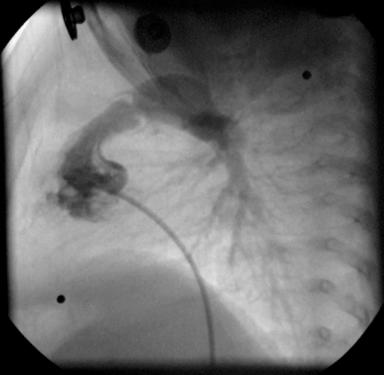
Beyond the neonatal period, most patients with PS are asymptomatic. The right ventricle and atrium are usually able to compensate over a long time and maintain resting cardiac output. Typical symptoms are exercise intolerance with breathlessness and fatigue. With advancing age, RV compliance falls, and cyanosis may once again appear in cases of open interatrial communications (foramen ovale, atrial septal defect) due to right-to-left shunting. Chest pain, syncope, and sudden death rarely occur. Besides clinical features (ejection systolic murmur, systolic click, splitting of second heart sound) diagnosis is based on electrocardiography (right atrial enlargement), chest x-ray (prominent pulmonary segment, RV enlargement, variable calcification in older patients, pulmonary hypoperfusion), and transthoracic echocardiography. Echocardiography permits prior visualization of the nature of the valvar stenosis and assessment of the peak instantaneous systolic gradient by continuous-wave Doppler measurements. Table 56.1 represents the therapeutic strategy with respect to severity of the valve’s stenosis. In neonates there may be a patent arterial duct with left-to-right shunt and RV dysfunction with high-grade tricuspid regurgitation (TR). A critical PS requires emergency intervention with balloon valvuloplasty to reduce mortality irrespective of the measured gradient.
| Degree of Severity | Peak Doppler Gradient (at Rest) a | Interventional Therapy b |
|---|---|---|
| Mild | <40 mm Hg | No |
| Moderate | 40–60 mm Hg | May be indicated |
| Severe | >40 mm Hg | Indicated |
a In symptomatic patients and neonates with duct-dependant pulmonary circulation irrespective of gradient.
Percutaneous pulmonary valvuloplasty can be performed under conscious sedation or general anesthesia from a transfemoral approach. Fifty to 100 IU/kg heparin in children, or a standard dose of 5000 IU in adults, is administered routinely at the beginning of the procedure and repeated as required. A full aseptic technique is used. Broad-spectrum intravenous antibiotics are not given routinely for isolated balloon valvuloplasty. Standard right heart catheterization techniques are used to assess PA and RV pressures, to perform a pullback gradient, and to characterize the outflow tract anatomy with angiography favorably obtained from a lateral projection. Careful measurement of the valve’s annulus is made at this stage to inform subsequent catheter selection. After placing an end-hole catheter into a distal PA, an exchange wire (0.018- to 0.035-inch) is passed through this into a side-branch artery or through the duct into descending aorta in neonatal cases. This may optimize maneuverability of the balloon catheter. The diameter of the balloon catheter should be approximately 130% (120% to 150%) of the measured valvular annulus. After balloon preparation and advancing it over the guidewire, it should reach a position such that the stenotic pulmonary valve rests at the midpoint of the balloon ( Fig. 56.2 ). Partial inflation is useful to confirm correct positioning prior to subsequent complete inflation of 10 to 15 seconds and full waist obliteration. Repeated gradient measurements and angiographies confirm the results. In adults or patients whose pulmonary valve annulus exceeds 18 to 19 mm, a double-balloon technique is preferred.
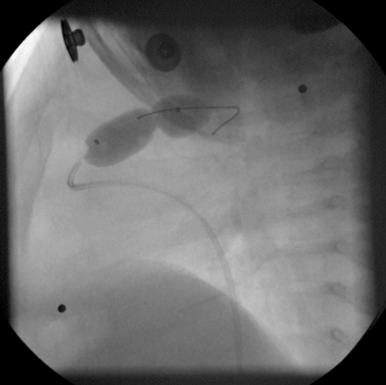
In general, percutaneous pulmonary valvuloplasty is an effective treatment strategy with a favorable long-term outcome irrespective of age. With 95% after 5 years, 88% after 10 years, and even 84% after 20 years, freedom from reintervention after percutaneous pulmonary valvuloplasty (mostly for restenosis, less for regurgitation) is comparable to the reintervention after surgical valvuloplasty (mostly for regurgitation). Outcomes in patients with dysplastic valves are more variable with a higher reintervention rate.
Major complications include rupture of the RVOT and cardiac tamponade and injury to the tricuspid valve. If applied by experienced interventionalists, only mild pulmonary regurgitation will be apparent in most cases; however, moderate or severe insufficiency can occur. In this situation, a PPVI could be considered (see later). Minor complications (venous thrombosis, hemorrhage, transient arrhythmia, risk of infection or reaction to contrast) appear as often as in other comparable procedures. After successful relieving of high-grade stenosis, dynamic infundibular obstruction with resulting hypotension and hypoxia is a particular risk in the young patient. If it occurs, fluid boluses, β-blocker infusion, and/or prostaglandin infusion to maintain ductal left-to-right shunting can stabilize the situation. Mortality of the percutaneous approach to relieve PS is even low in neonates (0% to 0.5%).
Over the past decades, advances in cardiac surgery, interventional procedures, intensive care, and noninvasive imaging have led to a substantial increase in life expectancy for many patients with congenital heart disease. This challenging, heterogeneous population of patients who were treated by corrective, semicorrective, or palliative surgical procedures, sometimes decades ago, is growing inexorably. Comparing birth registries for the years 1950–59 and 1990–99, the life expectancy of patients with congenital heart disease expressed by 18-year survival rates has increased from 10% to 70%.
Studies have shown that the number of adult patients with congenital heart disease are similar to those for the pediatric population and will continue to grow. For approximately 20% of these adults and children, late after neonatal repair of complex congenital heart disorders, such as tetralogy of Fallot, pulmonary atresia, persistent trunk, or d -transposition with RVOT obstruction, RVOT dysfunction manifesting as an obstructive lesion or as pulmonary regurgitation becomes clinically evident.
Surgical pulmonary valve replacement using valved homograft or porcine (e.g., Medtronic Hancock) and bovine xenograft conduits (e.g., Medtronic Contegra) helps to treat RVOT dysfunction. Undeniably the most frequent mode of repeat operation in patients with congenital heart disease, surgical pulmonary valve replacement is a safe procedure and is performed with low morbidity and mortality rates. However, an important drawback is the limited life span of the conduits. Due to growth-related undersizing and degeneration of the conduit causing obstruction or pulmonary regurgitation, conduit life span is approximately 10 years. Most patients must undergo several open heart procedures during their lives that raise potential risks for bleeding, adhesions, and sternal or cutaneous related complications.
To minimize the number of open heart operations, delaying surgical interventions for as long as possible has been the strategy of choice. This policy risks delaying necessary treatment beyond the point of no return, when RV dysfunction, impaired exercise capacity, and increased risk of sudden cardiac death, which can result from chronic adverse RV loading conditions, may be irreversible.
The correct timing for surgical pulmonary valve replacement is unknown and remains a highly controversial issue among cardiologists who take care of children and adults with congenital heart disease. Using magnetic resonance imaging (MRI), attempts have been made to establish RV volume thresholds as predictors of outcome after conduit placement. Cutoff points for RV end-diastolic volumes (EDV) have been reported, with some suggesting end-diastolic values of 150 to 170 mL/m 2 and end-systolic volumes of 85 to 90 mL/m 2 above which normalization of RV dimensions is less likely after pulmonary valve replacement. However, the impact of the timing of pulmonary valve replacement on RV function, exercise performance, and particularly, long-term survival remains undefined. Recently, after analysis of our cohort, we proposed QRS duration of <150 ms as valuable predictor of favorable outcome of RV remodeling after PPVI, because it represents electrical and mechanical functions of the right ventricle.
To postpone and potentially reduce the number of operations patients have to undergo throughout their lives, transcatheter stent implantation into stenotic conduits has been carried out, although bare-metal stenting can potentially convert a pressure overload due to obstruction into a volume overload due to free pulmonary incompetence. With the introduction of percutaneous valve implantation, a nonsurgical technique has become available. It enables treatment of RVOT obstruction as well as regurgitation or mixed states of RVOT dysfunction. This minimally invasive method can potentially avoid open heart surgery for RVOT dysfunction in children and adults by restoring acceptable RV loading conditions.
Since the first description of a percutaneously implanted heart valve in 2000, more than 10,000 PPVIs have been performed worldwide. The Melody device became commercially available in Europe and Canada in 2006. It was certified by Conformité Européenne (CE) in 2006 and approved by the FDA for clinical use in the United States in 2010, making the new percutaneous strategy available to a broader population.
PPVI is performed to prolong the life span of conduits from the right ventricle to the pulmonary artery (RV-PA) and therefore postpone open heart surgery in children and adults with congenital heart disease. Over the past 10 years, increasing operator experience with PPVI has resulted in improved safety, efficacy, and outcomes, including freedom from transcatheter or surgical reintervention for pediatric or adult patients who underwent this procedure.
Indications, technical aspects, and early and late results of PPVI using the Melody valve and the Sapien valve as nonsurgical treatment options for RVOT dysfunction are reviewed in the following sections.
The Melody transcatheter pulmonary valve is composed of a segment of bovine jugular vein with a central valve ( Figs. 56.3 and 56.4 ) sutured inside an expanded platinum-iridium stent. The currently used Cheatham platinum stent (CP Stent CP8Z34, NuMed, Hopkinton, NY) is 34 mm long; it can be crimped to minimum of 6 mm in diameter and reexpanded up to 22 mm. It consists of an eight-crown zigzag pattern with six segments along its length that are reinforced at each strut intersection with a gold weld. The venous segment is attached to the frame by continuous 5-0 polypropylene sutures around the entire circumference at the inflow and outflow and also discretely at each strut intersection. The suture is clear for all points except the outflow line, which is blue to signify the outflow end of the device. The valve is packaged and sterilized in a solution containing 1% glutaraldehyde and 20% isopropyl alcohol (see Fig. 56.3 ). The delivery system (Ensemble, Medtronic) contains a balloon-in-balloon (BiB) deployment design.
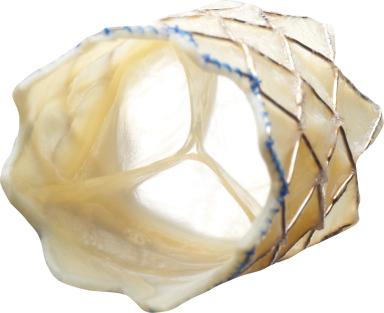
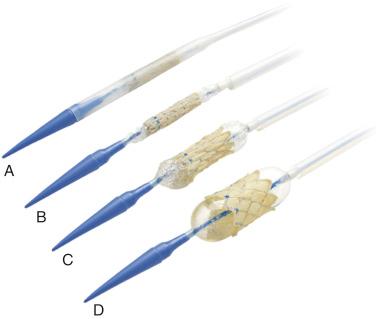
The Ensemble delivery system (Medtronic) contains a BiB deployment design. At its distal end, the valved stent is front-loaded and crimped (see Fig. 56.4 ). The system is available with outer balloon diameters of 18, 20, and 22 mm to fit different outflow tract diameters. To avoid incorrect implantation and potential failure, the tip of the delivery system is blue to correspond to the outflow suture of the device as described previously.
The body of the system is composed of a one-piece, 22-Fr Teflon sheath containing a braided-wire, elastomer-reinforced lumen. The retractable sheath that covers the stented valve during delivery is pulled back just before deployment. Contrast can be delivered through the retracted sheath from a side port to confirm positioning of the device before deployment. The proximal portion of the system has three ports, one for the g uidewire ( g reen), one to deploy the i nner balloon ( i ndigo), and one to deploy the o uter balloon ( o range) (see Fig. 56.4 ). Technical details regarding the Melody valve are summarized in Table 56.2 .
| Melody Transcatheter Valve | Sapien XT Transcatheter Heart Valve | |
|---|---|---|
| Manufacturer | Medtronic Inc., Minneapolis, MN | Edwards Lifesciences LLC, Irvine, CA |
| Regulatory approval | CE 9/2006 FDA 01/2010 |
CE 2/2011 FDA 6/2014 (aortic) FDA 2/2016 (pulmonic a ) |
| (Tissue) characteristics | segment of bovine jugular vein with a central valve hand-sewn inside a stent | trileaflet bovine pericardial valve hand-sewn inside a stent |
| Stent type | Cheatham platinum stent (NuMED CP Stent CP8Z34) Length 34 mm Expandable up to 22 mm |
stainless steel stent length of 14 or 16 mm |
| Available sizes | 18, 20, 22 mm (depending on the favored Ensemble delivery system | 23, 26, 29 mm |
| Delivery system | Ensemble (Medtronic, Minneapolis, MN) with balloon-in-balloon (BiB) deployment design | Edwards Retroflex III containing a balloon catheter and a deflectable guiding catheter |
| Sheaths for implantation | One-piece 22-Fr Teflon sheath | (16 Fr b ) 22 Fr for 23-mm valves (18 Fr b ) 24 Fr for 26-mm valves (20 Fr b ) 24 Fr for 29-mm XT valves |
The Edwards Sapien XT valve is radiopaque and made of a trileaflet bovine pericardial valve that is sewn by hand into a stainless steel stent (14 or 16 mm long) ( Fig. 56.5 ). A fabric polyethylene terephthalate sealing cuff covers the proximal part of the stent and is designed to prevent paravalvular leakage. The valve tissue is fabricated from three equal sections of bovine pericardium that have been preserved in glutaraldehyde to crosslink the xenograft tissue and preserve its flexibility and strength.
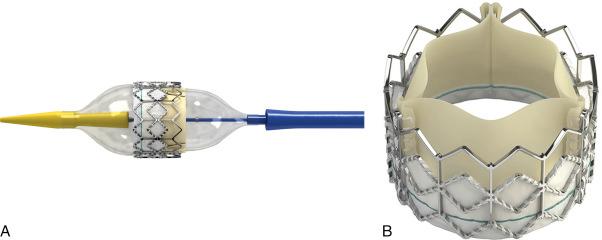
The device was initially designed for aortic valve replacement and obtained certification for PPVI later. Currently, the successor of the Sapien valve, the Sapien XT, is commercially available in 23-, 26-, and 29-mm-diameter sizes and is crimped onto the designated balloon delivery system (Retroflex).
In 2013, the third generation of the Retroflex III delivery system (Edwards Lifesciences) was FDA approved. It consists of a balloon catheter and a deflectable guiding catheter. The system requires a 22-Fr sheath (for the Sapien XT 23-mm valve) or 24-Fr hydrophilic sheath (for the Sapien XT 26-mm and Sapien XT 29-mm valve) (see Fig. 56.5 ). According to the manufacturer’s data, improvements in design (e.g., Edwards eSheath, Edwards Lifesciences) offer smaller sheath sizes for the 23-mm valve (16 Fr), the 26-mm valve (18 Fr), and the 29-mm XT model (20 Fr). The guiding catheter has a control handle on the catheter hub, which can be rotated to deflect the catheter passing through the tricuspid aperture to the RVOT. The Retroflex III system also contains a retractable nose cone catheter, which facilitates atraumatic delivery. Technical details regarding the Sapien valve are summarized in Table 56.2 .
Become a Clinical Tree membership for Full access and enjoy Unlimited articles
If you are a member. Log in here